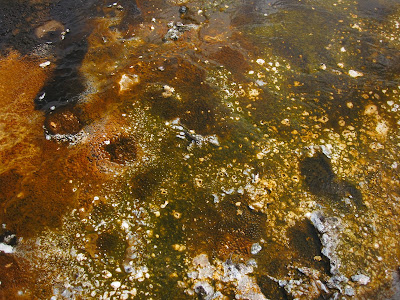The drive to Yellowstone - starting on Wednesday, August 21 - was good: it was pretty, bordered on both sides by parts of the Rockies and spotted with lakes. And like much of Montana, we saw few other travelers the entire time. We stopped in Helena, MT for one night and treated ourselves to dinner out after the long stretch of camping. It hit how far away from home we were when Jenna ordered a beer with dinner: our waiter, in his mid-forties, remarked that he had never seen a Virginia license before and that it "looked neat."
We met Drew and Maddie in the park, ending a two week stretch void of familiar faces while traveling through the barren Midwest. I was certainly glad to see a fresh, well-known face - especially from such an old friend. We set up camp on Thursday and did a small hike around Yellowstone Lake, and on Friday morning, we ventured out onto the lake in a rented rowboat together. We found out that rowboats, which require rowing in pairs, are more a test of strength and communication than a relaxing morning on the lake - though we definitely had a good time with it.
We explored Yellowstone's signature geothermal fields. I knew little about these going in - only that Old Faithful was here - but they were spectacular, and it was the highlight of the park for me. Hot magma flows close under the ground here, causing the groundwater to become heated and pressurized to the ponit of creating geysers and springs on the surface. This water deposits dissolved rock, harbors nearly-alien rainbow-colored bacteria, and creates a landscape that you might envision on Venus.
The springs and geysers are more than pictures can convey. The sounds are wild; some geysers dry up and become steam vents that whistle and howl so loud it sounds like a tornado. The smell is distinct too - reactions with acid, mud, and bacteria produce produce a strong, distinct sulfur odor that covers the geothermal fields. The water is generally about 150 F even on the surface, so there are always huge clouds of steam rolling off the top of the springs.
 |
| Anaerobic, heat-loving bacteria thrives in the mineral water |
 |
| A huge hot spring: we could see down to at least 40 or 50 feet |
 |
| A "mud pot" where the steam and heat bubbles up through mud pits |
We watched the famous Old Faithful go off as well, which was obviously a popular attraction in the park. Interestingly, the geyser was named so because it went off every hour about 100 years ago. Now, it erupts every 90 minutes, and as the underground conditions constantly change, it could slowly die out - not really so old or faithful after all.
 |
| Old Faithful |
 |
| And the crowd watching |



No comments:
Post a Comment